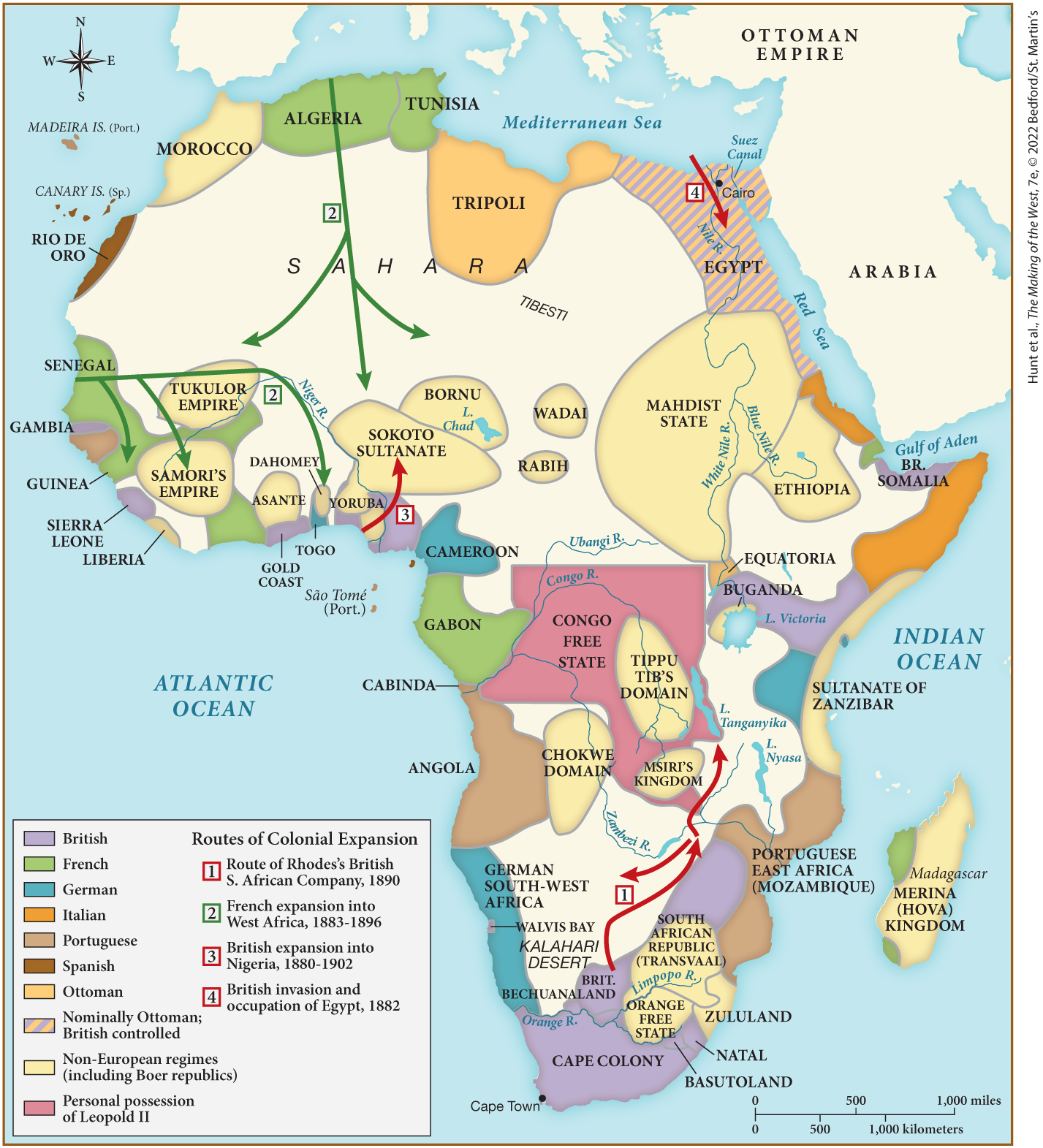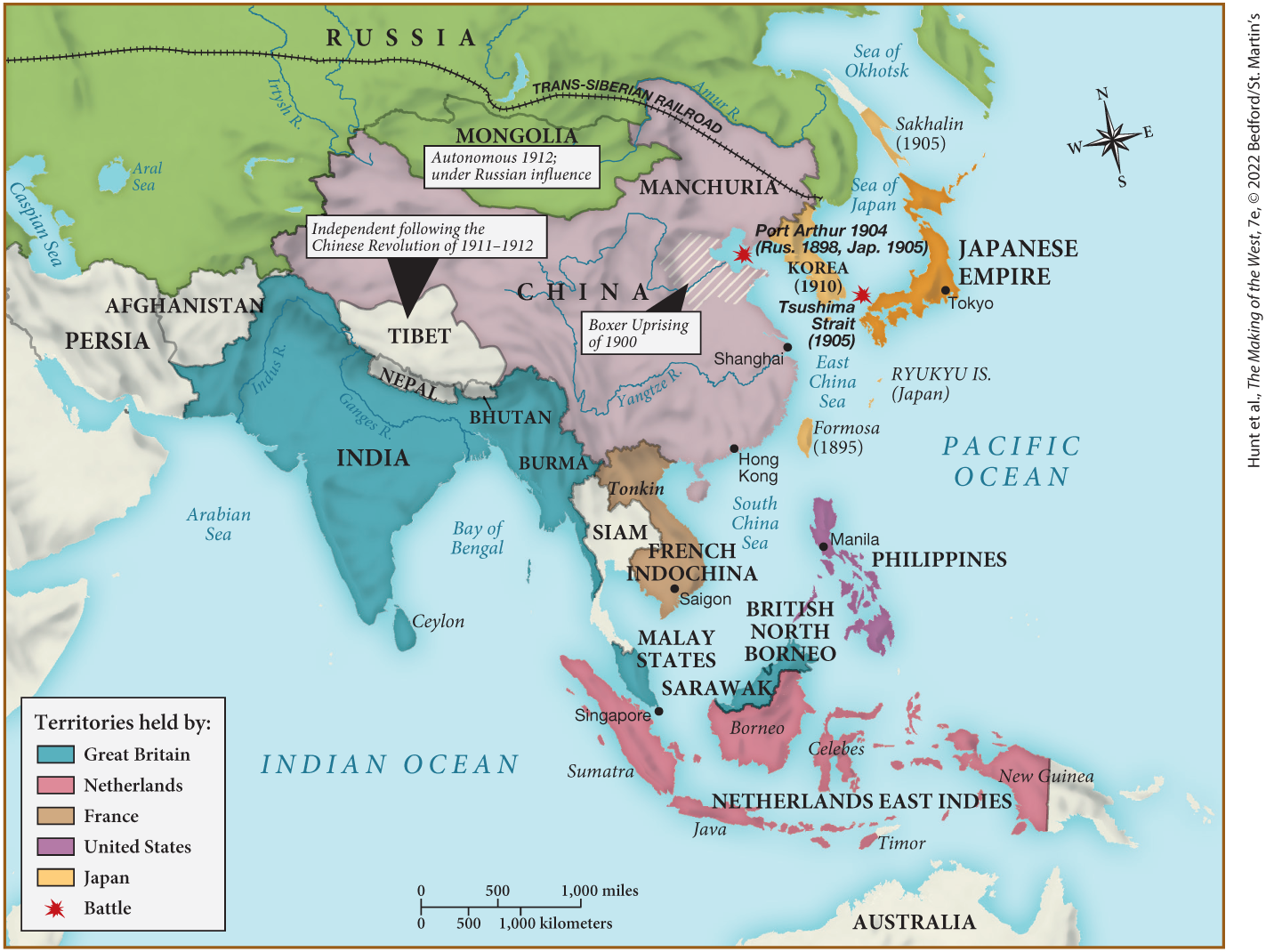Modern Western Civilization Exam 2
1/70
There's no tags or description
Looks like no tags are added yet.
Name | Mastery | Learn | Test | Matching | Spaced |
|---|
No study sessions yet.
71 Terms
What were the most frequent destinations for international migrants who left Europe seeking economic opportunity?
North and South America, Australia, and New Zealand
What major step did European governments take to raise investor confidence in the wake of the economic crisis of the 1870s?
They passed new laws to create the limited liability corporation.
In the late nineteenth century, industrialization tended to be capital intensive, which meant that
large amounts of money were needed to buy expensive machinery and equipment.
As industrialization advanced, the two problems that began to plague entrepreneurs most were skyrocketing start-up costs and
the failure of consumption to keep pace with production
The Trans-Siberian Railroad played a key role in the expansion of what country into northern Asia?
Russia
Spain and Belgium abruptly awarded suffrage to all men in 1890 and 1893, respectively,
yet both countries remained monarchies.
Women's massive entry into the service sector in the late nineteenth century accelerated what social change?
The division of occupations into male and female categories
Which of the following is an example of the opening of the political process to wider participation in Europe?
William Gladstone's 1879 campaign to be prime minister of Great Britain

Which of the following statements is supported by this map?
The French sought to expand further into the interior of West Africa in the 1890s.
Many European advocates of imperialism believed that whites had a “civilizing mission”; what did this mission entail?
Spreading superior European knowledge and culture to colonial subjects through education or even violence, if necessary
In general, why did large numbers of emigrants depart from rural Ireland and Scandinavia?
The population was expanding so rapidly that these countries did not have enough jobs at which to employ the growing labor pool.
Which of the following European countries was the slowest to industrialize?
Russia
Why did Kaiser William II dismiss Otto von Bismarck from the German government in 1890?
He became convinced that Bismarck not only hindered his nationalistic plans but also might prove to be a rival for power.
Which of the following factors was essential to the emergence of a “white-collar” service sector in the late 1800s?
Compulsory primary school education, which allowed workers to acquire literacy and mathematical skills they could use in offices
How did the Ottoman Empire change after 1878?
It decreased in size as Romania, Bulgaria, Serbia, and Bosnia-Herzegovina became their own territories.
Which of the following was manifested in the development of team sports and leisure activities like mountain climbing and bicycle touring in Europe?
The drive to increase national strength and promote imperial citizenship through the nation's exercise of raw power
Which of the following two countries came to rival Britain in industrial strength?
Germany and the United States
Which of the following was a major industrial innovation of the late nineteenth century?
Refrigeration
The growth of revolutionary movements in Russia in the late nineteenth century resulted in which of the following events?
The assassination of Tsar Alexander Il in a bomb attack
The establishment of maternal and child health centers and clinics was the result of
the belief that working women had become “defeminized” by entering the public sphere and therefore needed instruction in caring for infants and children.
What ideology helped enable the expansion of European imperialism by using racist ideas of European superiority to justify the conversion of trade with Africans into conquest of their lands?
Social Darwinism
The demand for raw materials along with business that was brought on by industrialism led to a rise in
imperialism.
By 1890, which European nation claimed territory on each of the continents shown on this map?
Great Britain
The Second International (1889) was an organization that sought
Marxist revolution.
What resulted from the Berlin conferences of 1884 and 1885 that determined European control of Africa?
A linear dissection of the continent that cut across indigenous boundaries of African ethnicities, a ban on the sale of alcohol, and limits on the flow of firearms to Africans
The French followed up their colonization of Algeria by occupying what territory?
Tunisia
What German institution did German chancellor Otto von Bismarck (1815-
1898) attack in 1878, after the failure of his Kulturkampf?
The Social Democratic Party
Which of the following is an example of how empire reshaped the daily lives of the European upper classes?
Wealthy Europeans decorated their homes with trophies of big-game hunting expeditions in Africa and Asia, as well as imperial treasures like Oriental carpets, furniture, and exotic plants.
The new mass journalism of this period was characterized by
an increase in sensational stories in newspapers and an emphasis on spreading information quickly.
Why was the Third Republic so unstable despite its new democratic institutions?
Economic downturns, widespread corruption, and growing anti-Semitism, fueled by a highly partisan press, kept the republic on shaky ground.
What was one of the main purposes of the Dual Alliance forged by Germany and Austria-Hungary in 1879?
To defend against Russian aggression, particularly in the Balkans
Why was Egypt an early and attractive target for European takeover in the age of imperialism?
Egypt's modernizing rulers had already built a thriving commercial and manufacturing center, and Egypt provided a convenient stopping point on the way to Asia.
As part of its program for modernization, the Meiji government in Japan
sent students, entrepreneurs, and government officials to the West to gain knowledge of technology and industry
Which of the following authors wrote a series of books that reflected his concerns about social decay?
Emile Zola
In the 1880s, Dutch physician Aletta Jacobs opened the first clinic in Europe to provide
birth control for women.
In which empire did the Young Turks come to power in 1908?
The Ottoman Empire
The British theorist Havelock Ellis emerged as a practitioner of the new field of
sexology.
How did cubism and expressionism differ significantly from art nouveau?
Cubism and expressionism stressed the unpleasant aspects of industrial society, while art nouveau strove to offset the harshness of industrial society by emphasizing beauty.
Why did nationalist and anti-Semitic politics flourish in late-nineteenth-century Germany?
As agriculture declined due to industrialization and agrarian elites lost power, they blamed Jews for destroying traditional society.
Why did nationalist and anti-Semitic politics flourish in late-nineteenth-century Germany?
As agriculture declined due to industrialization and agrarian elites lost power, they blamed Jews for destroying traditional society.
Why did British officials sponsor the Muslim League in India?
They wanted to divide Muslims and Hindus in the Indian National Congress.
How did the Italian prime minister Giovanni Giolitti respond to the urban working classes and rural laborers who demanded political change in the years before World War I?
He instituted social welfare programs and nearly universal manhood suffrage.
In 1896, a Hungarian-born Jew named Theodor Herzl published a book that called for the creation of a Jewish nation-state, which was the goal of what major movement?
Zionism
What was the name given to the growing number of women who challenged accepted views of women's dependence and seclusion in the home at the beginning of the twentieth century?
The New Woman
What caused Britain to enter World War I in 1914?
Germany violated Belgian neutrality.
Women's rights activists came mainly from which class?
The middle class
Which of the following marriage reforms did Europeans propose in the late nineteenth century?
Giving women equal control of finances in marriage, legalizing divorce, and providing government subsidies for mothers
The work of some late-nineteenth-century philosophers known as pragmatists and relativists reflected a change in Western perceptions of the world and argued that
human understanding was contingent upon the complex and ever-changing conditions of daily existence, and therefore no theory or standard was ever definitive.
In France, anti-Semitism became a hotly contested political issue with the 1894 arrest of Alfred Dreyfus, a Jewish army officer, for espionage, particularly after
Émile Zola published an article titled “J'accuse” on the front page of a popular Paris newspaper.
What factors contributed to the massive increase in the European population at the turn of the twentieth century?
Improvements in public health and sanitation that extended the human life span and lowered infant mortality rates

According to this map, Great Britain controlled which of the following territories during the late nineteenth and early twentieth centuries?
India
What was the name of the ultranationalist, anti-Semitic leader of Austria's Christian Social Party who was elected mayor of Vienna in 1895?
Karl Lueger
Despite the fact that the overall population in the West was growing at the end of the nineteenth century,
the birthrate was falling in almost every country.
Violent attacks against Jews in Russia were known as
pogroms
In the event that sparked World War I, the Austrian archduke Francis Ferdinand and his wife were assassinated by a nationalist named Gavrilo Princip, who was from which European country?
Bosnia-Herzegovina
Like other expressionist art of the period, the Norwegian artist Edvard Munch's painting The Scream (1893) conveyed
the political outrage and horror of modern life felt by many Europeans, particularly in the face of middle-class optimism.
At the beginning of the twentieth century, Europe found itself divided into two rigid diplomatic and military camps, the one "wild card" being
Great Britain.
How did Russia respond to the rise of Japanese imperialism in the late nineteenth century?
By building the Trans-Siberian Railroad, sending Russian settlers eastward, and sponsoring anti-Japanese groups in Korea
After a brief war in 1898, Spain lost Cuba, Puerto Rico, and the Philippines to which country?
The United States
How did V. I. Lenin (1870-1924) come to prominence in Russian Marxist circles?
He used his Bolshevik faction to outflank the Mensheviks at an important party meeting in 1903.
What was the Entente Cordiale?
A secret British-French alliance that recognized British claims in Egypt and French claims in Morocco
The Russian Ballet's performance of Igor Stravinsky's The Rite of Spring in 1913 was
a dance done to primitive rhythms with experimental forms of bodily expression and awkward poses.
Many educated Europeans at the turn of the twentieth century believed in a set of ideas called eugenics, which argued that
humans could produce "superior" people through selective breeding and that it was their national duty to prevent the disabled and other "inferior" degenerates from reproducing.
Which of the following is an example of the power of European working classes at the turn of the century?
The election of candidates from workers' political parties to national legislatures
How did the Boxer Uprising in 1900 affect European relations with China?
After European colonial powers put down the uprising, the Qing dynasty was discredited, leading to its overthrow and the eventual weakening of Western Imperialism.
What is one way in which Albert Einstein's special theory of relativity challenged mainstream scientific principles?
It argued that space and time were not absolute categories, as scientists had always believed, but varied according to the vantage point of the observer.
Why were political leaders reluctant to call a halt to the arms buildup in the years leading up to the outbreak of World War I?
They feared that cutting back would lead to unemployment and unrest.
The South African War (or Boer War), which ended with Britain's defeat of the Boers in 1902, began when
Cecil Rhodes ordered a raid into the Transvaal to stir up conflict between Boers and British immigrants.
Which of the following issues became a hotly debated talking point among European politicians at the beginning of the twentieth century?
Immigration
In 1911, Liberals in Britain initiated a new social policy funded by new taxes on the wealthy that was known as the
National Insurance Act, a system of relief for the unemployed.
In 1905 and 1911, Germany risked conflict with France by attempting to assert its strength in
Morocco.